Inflation came strongly out of the gate in 2017. After nearly half a decade below the Fed’s target, the PCE deflator reached 2 percent in January amid a rebound in energy prices and pickup in core inflation. It looked as if both parts of the FOMC’s dual mandate were finally giving a clear greenlight to raise interest rates.
That all came crashing down in March, however. Core inflation fell 0.2 percent, which was bigger than the cumulative decline registered over the entire Great Recession. Driving the drop was a 7.0 percent decline in wireless phone services as falling plan costs coincided with new ways in which the BLS adjusted for changes in plan quality. Although only a sliver of the CPI with a weight of 1.5 percent, the drop in March was enough to subtract 0.2 percentage points off the year-over-year rate of headline inflation and kick off a run of disinflation that lasted through the summer. Could we be in for another such surprise in 2018?
Our baseline forecast is for inflation to slowly strengthen over the course of the coming year. Further tightening in the labor market and the unwinding of what we believe to be largely one-off effects should push inflation higher. A 5 percent decline in the dollar since January and stronger global inflation should also lend some support to core goods prices as import prices rise.
Offsetting the upward thrust of these dynamics, however, is likely to be further declines in the prices of autos as replacement demand from recent natural disasters will not be enough to right-size dealer inventories and absorb the swath of vehicles coming off lease. At the same time, competitive pressures generated by new technology and the slow sales environment, as well as low inflation expectations, will continue to weigh on firms’ ability and willingness to raise prices.
That said, there is no shortage of sources that could knock inflation off our projected course for 2018. A stronger labor market is no guarantee of wage growth as we have seen in recent years, and even higher labor costs do not necessarily mean higher prices if margins are reduced. On the flip side, since the reasons behind inflation’s more modest response to labor conditions are not well understood, there is the risk that the link reasserts itself more quickly than anticipated.1 Throw in the potential for unusual weather, a collapse in trade agreements, other geopolitical crises and the typical noise in inflation data that can emerge from small sampling, and the inflation story could change dramatically in 2018. In this report, we focus on five specific inflation categories that have the potential to drive an inflation surprise next year.
1. Inflator: Natural Gas – From One Weather Extreme to Another
Heading into the draw down season, natural gas in storage is currently at the lowest level for this time of year since 2014 (Figure 1). This alone would not be enough to generate higher heating costs in the coming months, but when combined with unusually cold temperatures this winter, prices could jump. The National Oceanic and Atmospheric Administration is predicting a 65-75 percent chance of La Niña weather patterns this year, which would bring colder-than-average temperatures to the Northwest, Midwest and heavily populated Northeast.
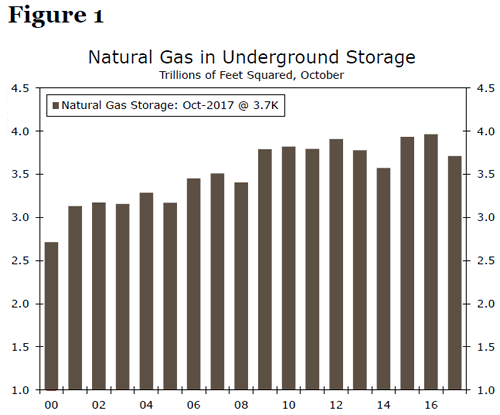
There has been no shortage of extreme weather lately. With the past two winters cracking the top 10 warmest on record, if this winter went from one extreme to the other, natural gas prices could soar like in early 2014. That winter was only the 29th coldest on record, but saw consumer prices for utility/piped gas services jump 16 percent between December 2013 and March 20142 (Figure 2). When combined with prices for electricity (for which natural gas is now the number one source), utility services had lifted the year-over-year rate of headline CPI by 0.3 percentage point by March.
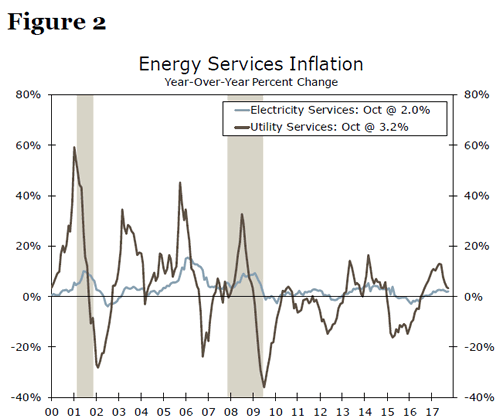
2. Inflator: Food Away From Home – Not to Be Minimized
The cost of dining out has grown more slowly over the past two years. The 12-month change in the CPI for food away from home, which carries a 5.8 percent weight in the index, has fallen by half a percentage point since mid-2016 (Figure 3). That slowdown is ripe for a reversal, however. Prices for food away from home are especially sensitive to changes in minimum wages given the high share of low-wage workers in the hospitality industry. In 2018, 20 states are scheduled to raise the minimum wage (Figure 4). That is slightly fewer than in 2017 (22), but recent research from the Boston Fed finds that inflation is raised by minimum wage hikes not only in the first year in which they go into effect, but also the following year.

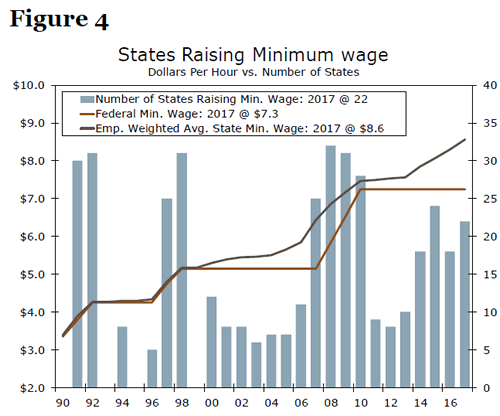
While a growing number of states and cities have been raising the minimum wage in recent years, restaurants and other food prep establishments have gotten a respite from declining food costs. That breathing room could change in the coming year as food costs are beginning to rise again. The Commodity Research Bureau food index is up 6.8 percent over the past year, the largest increase since 2014 when more states began to raise the minimum wage.
3. Inflator: Medical Care – "Healthy" Inflation Again
Medical care price growth has moderated somewhat in recent years amid efforts by insurers and the government to rein in costs (Figure 5). However, upward pressure from drug prices and labor costs could boost the CPI for medical goods and services in 2018. Prescription and over-the-counter drugs make up about 1.8 percent of the CPI consumption basket while medical services contribute 6.6 percent, giving them considerable weight in the overall CPI. As recently as September 2016, an upswing in medical goods and services contributed more than 43 basis points to year-over-year CPI inflation.
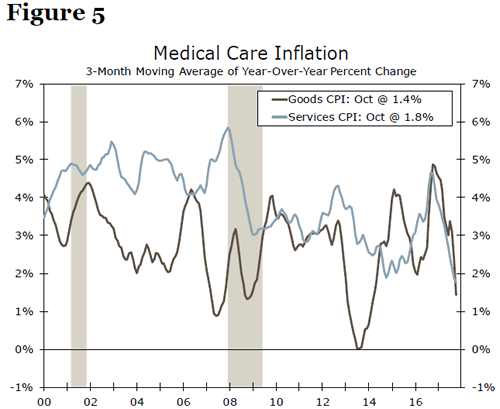
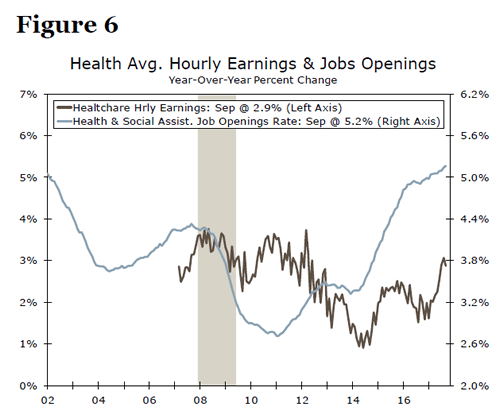
Fewer generic drugs are set to enter the market in 2018, which will likely push up prescription drug inflation. According to the PWC Health Research Institute, the sales value of drugs coming off patent protection declined by 32 percent in 2016 and 41 percent in 2017 from a year earlier.4 Cost savings from generics usually show up 1-2 years after patent expiration, so the impact of fewer patent expirations in the past two years should be felt in 2018. Since generic alternatives cost 80-85 percent less than branded drugs, their presence (or absence in this case) in the market can make a substantial difference to medical goods costs.
Higher labor costs as the labor market continues to tighten are also likely to put upward pressure on medical care prices. More than half of the industry’s input costs is employee compensation, and wage costs have been picking up over the past year. With the rate of job openings also trending higher, we expect to see higher labor costs to put more upward pressure on the services component of medical inflation.
4. Deflator: Rent of Primary Residence – The Affordability Wall
Slower rent growth may be in the offing next year as the torrent of multifamily housing supply since the recession and eroding affordability collide. Shelter costs represent some of the largest slices of the CPI basket (altogether 30 percent), with rent of primary residences making up about 8 percent. Industry measures of apartment rent growth, which tend to lead the rent-of-primary-residence component of CPI, have slowed over the past year (Figure 7).
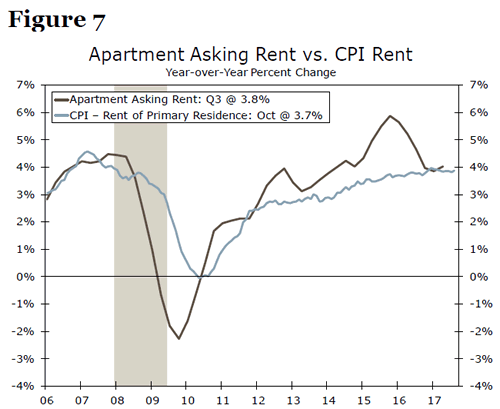
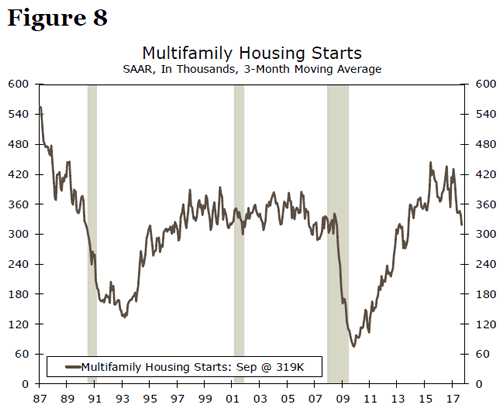
We see a risk that developers overestimated the future strength of demand for multifamily properties and have overbuilt. Multifamily housing starts reached a level in February not seen since 1989, and higher vacancy rates point to the surge in supply outpacing demand. Homeownership rates have stabilized this year, helped by easier credit and low interest rates. At the same time, rent continues to grow faster than household income. The CPI for rent of primary residence rose 25 percent since the start of the expansion in 2009, but median household incomes have expanded 18 percent. Unlike the purchase market where financing terms can keep monthly payments in check, landlords may be unable to continue raising rents at the same pace until incomes catch up.
5. Deflator: Lodging Away from Home – Hotel Headaches
Growth rates in the CPI for lodging away from home have already moderated this year. However, there is scope for a more dramatic fall if a mismatch between hotel supply and demand pulls down occupancy further, and hotel managers respond with substantially lower rates. Hotel occupancy rates have declined slightly in 2017 after peaking in Q4-2016 (Figure 9). Vacancies put pressure on room rates as hotels compete for customers with discounting and special offers; real room rates fell year-over-year in Q3 for the first time since Q2-2010 on a seasonally adjusted basis. While the weight of lodging away from home in the CPI is small – just 0.9 percent – changes in this component have moved the headline by as much as 8 basis points in recent years, and when combined with other factors can make a palpable difference to inflation.

An uptick in the number of hotel rooms in planning or construction phases this year suggests that hotel occupancy may continue to be a challenge in 2018, as new supply outpaces demand. Rooms in the pipeline as a share of existing supply were up 1.4 percentage points in October compared to January 2016 (Figure 10). Given an average construction lead time of eight months for private nonresidential projects, these hotel rooms will likely feed into supply early next year. Services such as Airbnb are also providing lodging alternatives to traditional hotels and increasing competition for attracting customers.

Meanwhile, macroeconomic factors are not supportive of sizable increases in hotel demand in the near future. Corporate profit growth is expected to be in only the low-single digits next year, limiting growth in business travel. Meanwhile, modest growth in disposable income is also holding back growth in leisure travel. U.S. air travel shrank this year, with passenger enplanements down 2.9 percent year-to-date compared to 2016. Given our forecast for modest corporate profit and disposable income growth into next year, we expect continued softness in travel activity and associated hotel demand.
Conclusion
Inflation is notorious for being knocked around by a few categories. While inflation watchers are accustomed to the volatility caused by food and gasoline prices, this year was a reminder that other categories that are typically more stable and/or smaller can have meaningful effects on aggregate price movements. We are watching a number of categories that could similarly upset our baseline forecast of moderately stronger inflation next year. These items, however, offer the potential of both upside and downside pressure. As a result, we see the risks these categories present to our forecast as roughly balanced.














